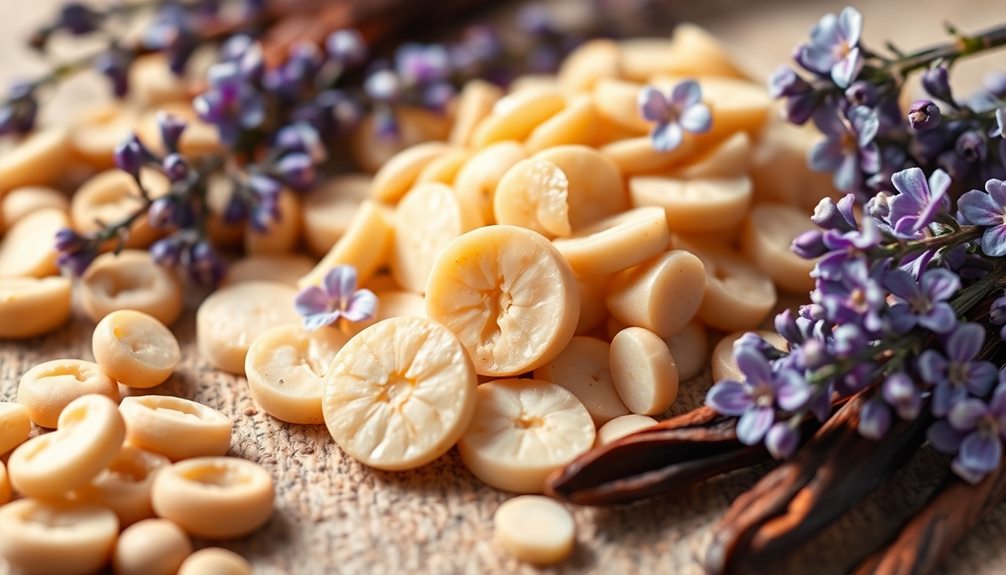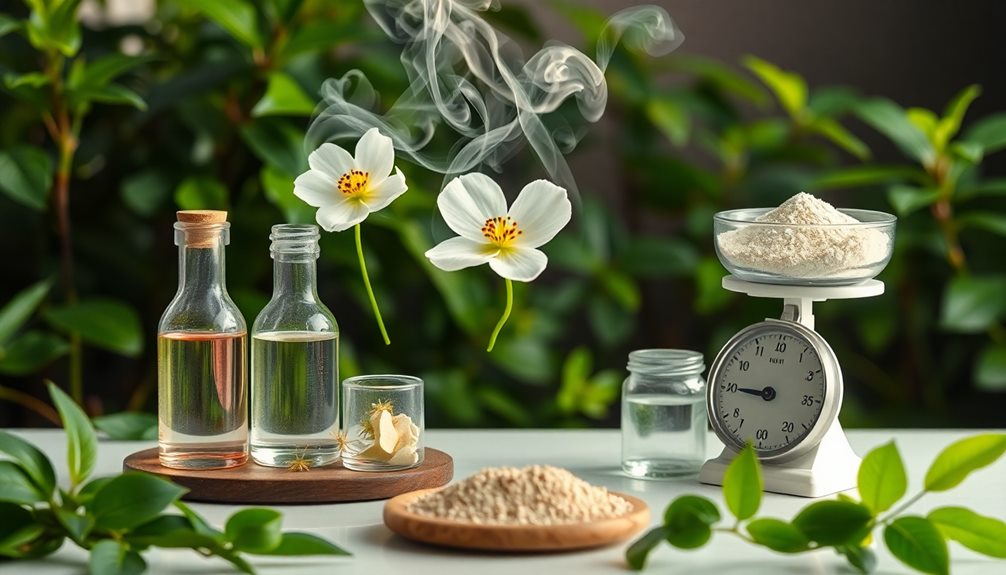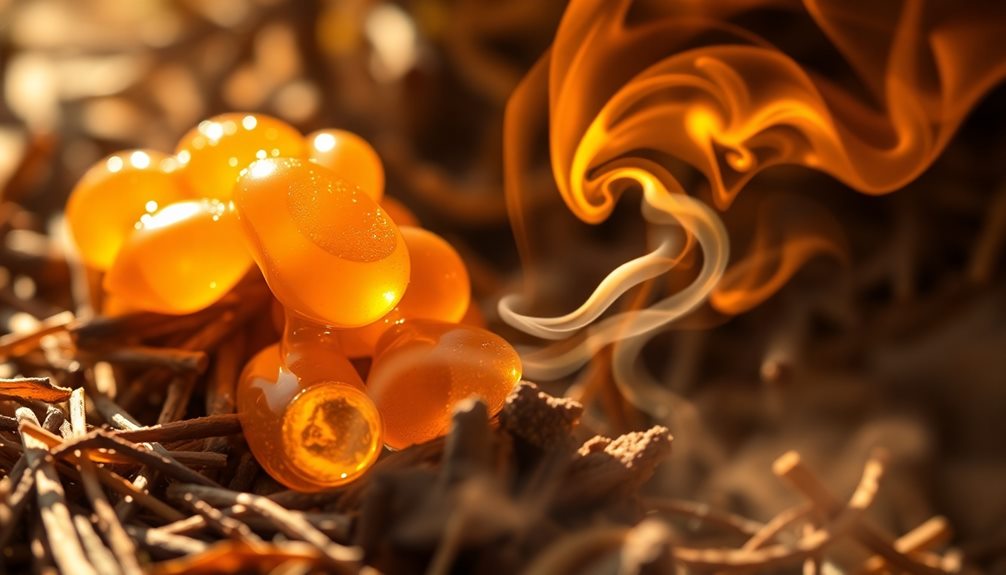Coumarin smells warm and sweet, like freshly baked cookies mixed with hints of vanilla and fresh-cut grass. It reminds you of sunny afternoons spent in blooming gardens or cozy cafés filled with delightful treats. This lovely aroma comes from plants like tonka beans and cinnamon, adding a comforting touch to everyday moments. Imagine strolling through a farmer's market, where the scents of hay and ripe fruits blend beautifully! Just be aware that some people may have sensitivity to it, so it's wise to enjoy it safely. There's so much more to discover about this charming scent, so keep exploring!
Key Takeaways
- Coumarin has a warm, sweet scent, often described as reminiscent of vanilla and fresh-cut grass.
- The fragrance features subtle earthiness, creating a cozy and inviting atmosphere.
- It evokes imagery of freshly baked cookies, warm meadows, and blooming flowers.
- Commonly derived from tonka beans, it is prevalent in perfumery and culinary uses.
- Coumarin enhances everyday experiences, making ordinary moments feel special and memorable.
Introduction

Coumarin captivates the senses with its distinctive aroma, often described as sweet and reminiscent of freshly cut hay or sweet vanilla. This delightful compound, which you might find in some perfumes and flavorings, has a fascinating background that makes it even more interesting.
It's naturally present in various plants, especially in tonka beans and cinnamon, giving those items their lovely scent.
When you smell coumarin, it's like being transported to a warm, sunny meadow. You can almost feel the gentle breeze carrying the fragrance of blooming flowers and ripe fruits. Isn't that enchanting?
Coumarin not only pleases your nose but also sparks curiosity about its uses. From enhancing food flavors to creating inviting aromas in candles, its versatility is truly remarkable.
As you dive deeper into the world of coumarin, you'll discover how it plays a role in your daily life. Whether you're baking a cake or simply enjoying a stroll through a garden, that sweet scent brings a certain joy.
Description of the Smell

When you take a whiff of coumarin, you're greeted by a warm, sweet scent that combines hints of vanilla and fresh-cut grass. It's like walking through a lush garden on a sunny day, where the aroma of blooming flowers dances in the air. You might even pick up on a subtle earthiness that adds depth to its sweetness, making it feel cozy and inviting.
As you inhale deeper, you'll notice that coumarin has a creamy texture. It wraps around you like a soft blanket, bringing a sense of comfort. Imagine the smell of freshly baked cookies mingling with a hint of herbal freshness—it's a delightful combination that can brighten your mood.
You might find it reminiscent of a lazy afternoon spent outdoors, where the scents of nature blend perfectly with the sweetness of your favorite dessert. The fragrance is captivating, drawing you in and making you want to experience it again and again.
Whether it's in a candle, perfume, or even a scented lotion, coumarin's aroma has a way of making ordinary moments feel special and memorable. So, take a moment to enjoy its enchanting scent!
Source and Composition

One of the key sources of coumarin is the tonka bean, a seed native to South America that's often used in perfumery and culinary applications. When you think of tonka beans, imagine their rich, dark color and sweet aroma that fills the air. This delightful scent comes from the natural compounds found in the beans, including coumarin, which gives them their unique fragrance.
Besides tonka beans, you might find coumarin in other plants, like sweet clover and some types of cinnamon. These plants also carry that warm, comforting scent that people love.
The composition of coumarin itself is quite fascinating—it's a chemical compound with a distinct sweet smell, reminiscent of vanilla and almond.
When you explore the world of fragrances, you'll notice how versatile coumarin can be. Whether in perfumes, candles, or even baked goods, this compound adds a delightful touch.
It's amazing how nature provides us with such wonderful ingredients that can transform everyday experiences. So, next time you catch a whiff of that sweet aroma, you'll know it's likely the magic of coumarin at work!
Typical Scenarios or Environments

In a cozy café, the warm aroma of freshly baked goods often mingles with the sweet scent of coumarin, creating an inviting atmosphere that draws you in. You might find yourself sitting at a small table, sipping a cup of coffee while the rich scent envelops you. This delightful smell can also be found in bakeries, where the sweet notes of vanilla and almond blend seamlessly with pastries and cakes.
Imagine walking through a farmer's market, where the air is filled with the earthy, sweet smell of freshly cut hay and ripe fruits. Coumarin can be hidden in the background, adding depth to the overall experience. You might even catch a whiff of coumarin while enjoying a leisurely stroll through a garden, surrounded by blooming plants and fragrant herbs.
In these everyday scenarios, you can sense how coumarin enhances the environment, making it feel warm and welcoming. It's like a gentle hug for your senses, reminding you of sweet moments in life.
Whether it's in your favorite café or a sunny garden, the scent of coumarin has a unique way of making ordinary places feel special.
Emotional or Cultural Associations

The scent of coumarin often evokes feelings of nostalgia and comfort, deeply rooted in cultural traditions around the world. You might remember the sweet aroma wafting through a kitchen, reminding you of freshly baked goods or homey desserts. This scent often brings back warm memories of family gatherings, where food and love were abundant.
In many cultures, coumarin is linked to celebrations and special moments. For instance, in some regions, it's a favorite in traditional sweets enjoyed during festivals. The fragrance can transport you to a cozy café, where you sip on a fragrant drink while catching up with old friends.
Coumarin's scent also appears in nature, like in fields of sweet clover or blooming flowers. These experiences connect you to nature and the changing seasons, enriching your emotional landscape.
Whether it's a memory of a loved one's cooking or a joyful occasion, the smell of coumarin creates a bridge to the past. It invites you to savor not just the aroma but the moments tied to it, reminding you of the beauty in everyday life.
Health or Safety Considerations

While coumarin's scent can bring back fond memories and evoke a sense of comfort, it's important to consider its health and safety implications. Some people may have allergic reactions to coumarin, leading to skin irritation or respiratory issues. If you notice sneezing, itching, or rashes when exposed to coumarin, it's best to steer clear of it.
Also, coumarin is found in some plants and essential oils, and the concentration matters. Using products with high coumarin levels can pose risks, especially for pregnant women and individuals with liver issues. It's a good idea to check labels on scented products or perfumes when you're shopping.
Remember, moderation is key! When using coumarin-scented items, like candles or air fresheners, ensure you're in a well-ventilated space. This way, you can enjoy the delightful aroma without overdoing it.
If you're ever unsure about a product's safety, don't hesitate to ask a healthcare professional. They can provide guidance tailored to your needs.
Final Thoughts

As you explore the enchanting scent of coumarin, it's essential to strike a balance between enjoyment and safety. This sweet, vanilla-like aroma can be delightful, evoking images of warm pastries and cozy evenings.
However, understanding its implications is crucial. While coumarin can create a delightful atmosphere, it's important to use it wisely, especially if you're sensitive to fragrances or have allergies.
Think about how you can incorporate this scent into your life. Whether through perfumes, candles, or essential oils, coumarin can enhance your environment.
Just remember to check the ingredients and ensure they're safe for you. You don't want to compromise your well-being for a lovely scent!
Frequently Asked Questions
Is Coumarin Used in Any Food Products?
Yes, you'll find coumarin in some food products, particularly in certain types of cinnamon, vanilla, and various flavored beverages. Just be cautious, as it can be restricted due to potential health concerns in large amounts.
Can Coumarin Be Found in Essential Oils?
Yes, you can find coumarin in some essential oils, especially those derived from plants like tonka beans and sweet clover. It adds a sweet, warm scent, making it popular in fragrances and aromatherapy products.
How Is Coumarin Produced Synthetically?
To produce coumarin synthetically, you'll typically start with salicylic aldehyde and react it with acetic anhydride. This chemical process creates coumarin, which can then be further refined for various applications.
Are There Any Natural Alternatives to Coumarin?
Yes, there are natural alternatives to coumarin. You can explore options like tonka bean, sweet grass, or lavender. These alternatives offer similar aromatic profiles, providing you with delightful scents without relying on synthetic compounds.
Does Coumarin Have Any Medicinal Properties?
You'll find that coumarin has potential medicinal properties, such as anti-inflammatory and anticoagulant effects. However, it's crucial to consult healthcare professionals before using it, as proper dosages and potential side effects must be considered.









